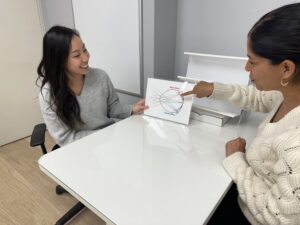April 1, 2024
By Vishakha Thakrar, OD, FAAO, FSLS
Implementing myopia management is no different than implementing other optometry specialties. We need to promote education and dedicate time to our associates to allow them to understand the importance of these services and then implement strategies for their success.

Dr. Thakrar takes the time to work closely with her associate ODs and make sure they’re all on board with myopia management.
Myopia management has been a key area of my practice since I opened several years ago. In that period, I witnessed and participated in the evolution of myopia control lenses from orthokeratology, soft lenses, atropine, and now, next-generation spectacles.
As with any new procedural change, team training is critical to the implementation. We often focus our training efforts on our staff, assuming our associate optometrists will jump on board with any new treatment the practice offers; however, this may not always be the case. Embracing new technology and treatments is vital for exemplary patient care and the practice’s growth. Implementing myopia management is no different than implementing other optometry specialties. We need to promote education and dedicate time to our associates to allow them to understand the importance of these services and then implement strategies to promote success.
Scheduled Meetings
Meetings between owners and associates provide a platform for open communication and create alignment between doctors. With regular meetings, you can establish your own myopia management protocol. Clear communication helps ensure that your team is aligned regarding the following:
- The importance of incorporating myopia management in the practice.
- Current myopia management devices, when to use them, and the advantages and disadvantages of each device.
- How to prescribe these treatments to patients.
- How to work with the staff to assist and educate patients.
- How to problem solve when challenges arise.
Regular discussions about myopia management are valuable for all parties. I can share processes, cases, and accomplishments, while receiving amazing feedback and ideas from my associates.
Educate Your Associates
Our associate optometrists need to be made aware that there has been an enormous shift in global myopia. As optometrists, we are in the unique position to slow down the progression of myopia and, in turn, impact the future of worldwide blindness.
I make sure to share the following statistics with my whole team to ensure that they understand the need for these therapies:
- 50% of the world’s population is estimated to be myopic by 2050.1
- There is no safe level of myopia.2
- The prevalence of myopia has nearly doubled in Eastern and Western societies in the past 20 years.3
- Myopia prevalence is estimated at 41.6% in the U.S.4,5
- The younger the age of onset of myopia, the greater the chance of sight-threatening levels of myopia.6
- Each diopter increase in myopia increases myopic macular degeneration by 67%.2
- Risk of visual impairment is greater than 25% in eyes with axial length ≥ 26 mm or greater and greater than 90% in eyes with AL ≥ 30 mm.3
- Myopia increases the development of glaucoma, cataracts, and retinal detachment.
This knowledge arms our associates with why myopia management is imperative for our patients. We can easily provide this information to them in written form or via discussion. Myopia management conferences, papers, and lectures will also solidify this information.
Training
Training associates can be done in numerous ways. Whether treating with atropine, soft contact lenses, OrthoK, or next-generation myopia control spectacles, we can be confident that the newer devices are beneficial. Associates should be trained in all these areas. Sharing current studies, real-life stories, and cases also have a significant impact on teaching.
Soft contact lenses: We are all trained in fitting soft contact lenses, but each myopia control contact lens is designed differently. Sales representatives are the greatest resource for training our team, including our associates. They provide modules, clinical insights, and tools for doctors, staff, and patients. For associates to be successful, little time needs to be allocated toward the training of soft lenses.
OrthoK: To bring OrthoK into the practice, a topographer is necessary, and training staff on the fitting of the lenses can be incredibly beneficial. Each company has a training program to teach ODs how to fit their lens. Conference workshops and lectures are also excellent ways to learn OrthoK from experts. However, hands-on experience is also necessary to problem solve. Block off time for your associate to shadow you when you see an OrthoK patient and work with them through cases. Many nuances with OrthoK can only be taught through experience.
Atropine: Atropine usage does not require much training, but ODs must keep up with current literature. We could facilitate this by forwarding pertinent papers to associates along with our feedback. Some ODs are using atropine as a monotherapy and others as combination therapy. Since I have had access to next-generation myopia management spectacles, the frequency with which I prescribe atropine as a monotherapy has reduced significantly, and I have found that my associates follow this practice.
Spectacles: Next-generation myopia management spectacles are not yet available in the U.S., but they are available in many countries around the world. The number of ODs practicing myopia management increased dramatically in Canada when we received myopia management spectacles. Parents tend to be more comfortable putting their young children in glasses over contact lenses and atropine. Like contact lenses, sales representatives provide many educational materials to support your team.
Hiring New Associates
When hiring a new associate optometrist, set the expectation right away that myopia management is an integral part of your practice. If the new associate has not been trained in myopia management, set up a training early. Training can be done by shadowing the myopia management specialist in the practice, CE conferences, webinars, journal articles, or Review of Myopia Management.
What About Secondary and Tertiary Care Practices?
My practice started as an advanced cornea and contact lens practice. My knowledge of OrthoK helped evolve my office into a myopia management practice, so transitioning my associates to myopia management was very straightforward. Bringing associates on board with these recommendations should be simple for those in a primary care practice. But what if you have a specialty practice and your associates are not interested in myopia management?
Myopia management crosses over into every category of optometric practice. If practitioners have an advanced ocular disease specialty, focusing on the eye diseases associated with myopia will drive a totally different category of patients into the practice.
If you have a pediatric/behavioral optometry practice, the patients are already in your exam chair. Your associates just need to embrace the technology and processes that are available.
Myopia management is an important part of optometry and is considered the standard of care by the World Council of Optometry. Our associates are critical to our practice growth, so we must engage and train them to feel confident with myopia management so they can prescribe the best evidence-based treatments to our patients.
 |
Dr. Vishakha Thakrar is the founder of Vaughan Vision Centre, an advanced specialty contact lens clinic, myopia, and dry eye clinic in Vaughan, Ontario. The practice focuses primarily on scleral lenses fitting, full-scope myopia management, vision therapy, and advanced dry eye treatment. She completed a Cornea and Contact Lens Residency at the New England College of Optometry. She then went on to become the Director of the Contact Lens Service at the Cole Eye Institute, Cleveland Clinic. She later helped establish the Contact Lens Clinic at the Kensington Eye Institute in Toronto. Dr. Thakrar has been fitting OrthoK lenses, scleral lenses, and treating ocular surface disease for over 20 years. She is a Fellow of the American Academy of Optometry and the Scleral Lens Society. She has spoken and written extensively for many years on contact lenses, dry eye disease, corneal disease, and myopia management. |
References
1. Holden B et al. Global Prevalence of Myopia and High Myopia and Temporal Trends from 2000 through 2050. Ophthalmology. 2016 May;123(5):1036-42.
2. Bullimore MA and Brennan N. Myopia Control: Why Each Diopter Matters. Optom Vis Sci. 2019 Jun;96(6):463-465.
3. Morgan et al. The epidemics of myopia: Aetiology and prevention. Prog Retin Eye Res. Jan:62:134-149.
4. Vitale S, RD Sperduto, FL Ferris. Increased prevalence of myopia in the United States between 1971-1972 and 1999-2004. Arch Ophthalmology. 2009 Dec;127(12):1632-9.
5. Bryana Banashefski, Michelle K. Rhee, and Gareth M. C. Lema. High Myopia Prevalence across Racial Groups in the United States: A Systematic Scoping Review. J Clin Med. 2023 Apr; 12(8): 3045.
6. Chua SY et al. Age of Onset of Myopia Predicts Risk of High Myopia in Later Childhood in Myopic Singapore Children. Opthal Physiol Opt 2016;36:388-94.
7. Haarman, A. E. G. et al. The complications of myopia: A review and meta- analysis. Invest. Ophthalmol. Vis. Sci. 2020. 61:49.













